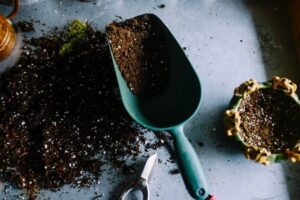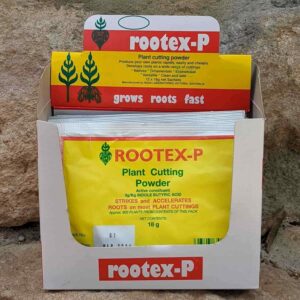Put simply, plant soil needs to strike a good balance between adequate plant nutrition and suitable drainage for the species we are growing. For cacti, we need to find a way to achieve high-nutrient but fast-draining growing mediums. This can be tricky, as plant nutrients are traditionally found in rich composts and animal manure, which are the exact opposite of fast-draining.

Before we get into the meat and potatoes of this article, it’s worth mentioning that we produce and sell a great ready-to-use cactus soil that caters to a wide range of cacti species – you can find here. So if you want to take the guesswork out we highly recommend grabbing yourself some of that. Or read on if you’d like to understand the theory a bit deeper.
In our Cactus Soil 101 guide, we provided the following recipe for cactus soil:
- 40% coarse perlite;
- 60% premium potting mix.
In this mixture, the cacti get all their nutrients from the soil. The sole purpose of perlite is to reduce the mixtures organic composition and increase the drainage capacity.
This is a decent mix for beginners to start with because it’s simple, cheap, and the components can be easily sourced from most regular garden stores. Most common varieties of cacti will survive in this mix, but it has 2 major failings. Firstly, it’s just missing a lot of really beneficial things like zeolite which do wonders for cactus health. And secondly, it doesn’t take into account the fact that every species of cactus has differing soil needs.
So, if you’re feeling like you’ve graduated from the basics and want to take your soil to the next level, read on.
Quick Tips
If you don’t have time to read the full article but want a couple of quick tips:
- Sand is a dead ingredient. It serves no purpose other than to dilute the organic makeup of the mix. Try and substitute it with something that also contains valuable nutrients, like crushed/decomposed granite;
- Perlite is also a dead ingredient but does a great job aiding drainage. Substitute for pumice, which achieves the same purpose but also contains nutrients;
- Vary the granulations to achieve good drainage. In nature, nothing is uniform, and you want to try to recreate this in your mix. For your minerals, try and include something 2-5mm, something 5-10mm, and if you want to go crazy, a few larger pieces as well;
- Not all potting soil is created equal, for some reason there is a whole subset of soil producers who convinced themselves that potting mix should be 80% finely graded bark. You don’t want that. Try to find one that looks like, well, soil. The colour should be black and the consistency reasonably fluffy/airy. I don’t want to open a can of worms with definitions here, but you should be able to look at it and go, “oh yeah, that looks like nice fertile soil”. If you open your bag of potting mix and it looks like a combination of sticks, bark and fine mulch – throw it in the bin.
What is the Best Cactus Soil Mix?
This is an impossible question to answer succinctly because the best cactus soil depends on the exact species of cacti you are growing, your climate and your growing conditions. All cacti are endemic to the Americas, but their natural range is enormous: from Canada down to the bottom of Argentina and everywhere in between. Some cacti grow in scorching deserts, some in cold mountains, and some cacti even grow in trees (we’re talking about YOU, dragonfruit).
So whilst it’s impossible to definitively provide a soil mix that is perfect for all cactus species – we can provide you with what works for us.
Below, we have shared some examples of soil mixtures we use for different species/types of cacti. In each group, we have included species examples as well as an overarching recommendation for organic/mineral soil composition. Organics are “living”, carbon containing components such as peat, compost, leaf mould, worm castings, etc. Minerals are “rocks” and include pumice, perlite, sand, granite, etc.
At the bottom of this page you will find a list of the top 50 most cultivated cactus genera, arranged alphabetically, with examples of their organic/mineral ratios. Generally speaking, soil needs don’t change enough between individual species, so listing these ratios at a Genus level should suffice for cultivation.
South American Columnar Cactus
Species examples: Echinopsis pachanoi (San Pedro), Echinopsis peruvianua (Peruvian Torch), Echinopsis terscheckii, Echinopsis cuzcoensis
Recommended composition: 60% organic, 40% mineral
Example Mix: 50% premium potting mix, 10% worm castings, 20% 2-5mm pumice, 10% 5-10mm crushed granite, 10% Zeolite 4-6mm
North American Columnar Cactus
Species examples: Carnegiea gigantea (Saguaro), Pachycereus pringlei (Cardon cactus), Neobuxbaumia polylopha
Recommended composition: 30% organic, 70% mineral
Example Mix: 20% premium potting mix, 10% worm castings, 40% 2-5mm pumice, 20% 5-10mm crushed granite, 10% Zeolite 4-6mm
Small Mexican Desert Cacti and Taproot Cacti
Species examples: Ariocarpus retusus, Astrophytum asterias, Obregonia denegrii, Turbinicarpus lophophoroides, Lophophora williamsii
Recommended composition: 10% organic, 90% mineral
Example Mix: 10% worm castings, 50% 2-5mm pumice, 20% 5-10mm crushed granite, 10% Diatomite, 10% Zeolite 4-6mm
Ball Cactus
Species examples: Echinocactus grusonii (Golden Barrel), Ferocactus, Parodia, Mammillaria
Recommended composition: 30% organic, 70% mineral
Example Mix: 25% premium potting mix, 5% worm castings, 45% 2-5mm pumice, 15% 5-10mm crushed granite, 10% Zeolite 4-6mm
Genus list
Below is a list of cactus genera and a guide on the organic to inorganic soil ratio you could use for them. Please note that this isn’t an exact science and you should experiment to see what works best for you, your climate and conditions. But this is what works for us and should serve as a useful starting point.
| Genus | Organic % | Inorganic % |
|---|---|---|
| Acanthocereus | 30% | 70% |
| Aporocactus | 70% | 40% |
| Ariocarpus | 10% | 90% |
| Astrophytum | 10% | 90% |
| Aztekium | 10% | 90% |
| Carnegiea | 30% | 70% |
| Cephalocereus | 30% | 70% |
| Cereus | 70% | 30% |
| Cleistocactus | 30% | 70% |
| Copiapoa | 10% | 90% |
| Coryphantha | 10% | 90% |
| Denmoza | 10% | 90% |
| Disocactus | 60% | 40% |
| Echinocactus | 30% | 70% |
| Echinocereus | 30% | 70% |
| Echinopsis | 60% | 40% |
| Epiphyllum | 60% | 40% |
| Epithelantha | 10% | 90% |
| Escobaria | 10% | 90% |
| Ferocactus | 30% | 70% |
| Gymnocalycium | 30% | 70% |
| Hatiora | 80% | 20% |
| Hylocereus | 60% | 40% |
| Lepismium | 60% | 40% |
| Leuchtenbergia | 10% | 90% |
| Lophophora | 10% | 90% |
| Mammillaria | 30% | 70% |
| Mammilloydia | 20% | 80% |
| Matucana | 30% | 70% |
| Melocactus | 30% | 70% |
| Myrtillocactus | 30% | 70% |
| Neobuxbaumia | 30% | 70% |
| Obregonia | 10% | 90% |
| Pachycereus | 30% | 70% |
| Parodia | 30% | 70% |
| Pediocactus | 10% | 90% |
| Peniocereus | 30% | 70% |
| Pereskia | 50% | 50% |
| Pilosocereus | 30% | 70% |
| Pseudorhipsalis | 60% | 40% |
| Rebutia | 30% | 70% |
| Rhipsalis | 80% | 20% |
| Schlumbergera | 60% | 40% |
| Selenicereus | 60% | 40% |
| Stenocactus | 10% | 90% |
| Stenocereus | 30% | 70% |
| Sulcorebutia | 30% | 70% |
| Tephrocactus | 30% | 70% |
| Thelocactus | 30% | 70% |
| Turbinicarpus | 10% | 90% |
Do you want us to add another mix to this list? Let us know here.



